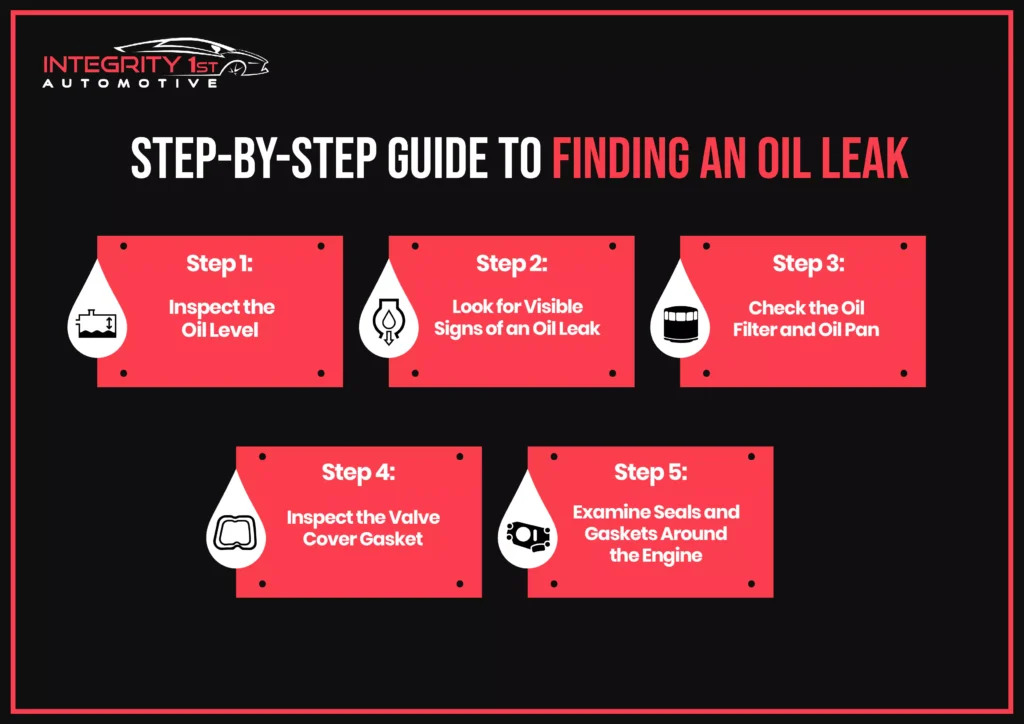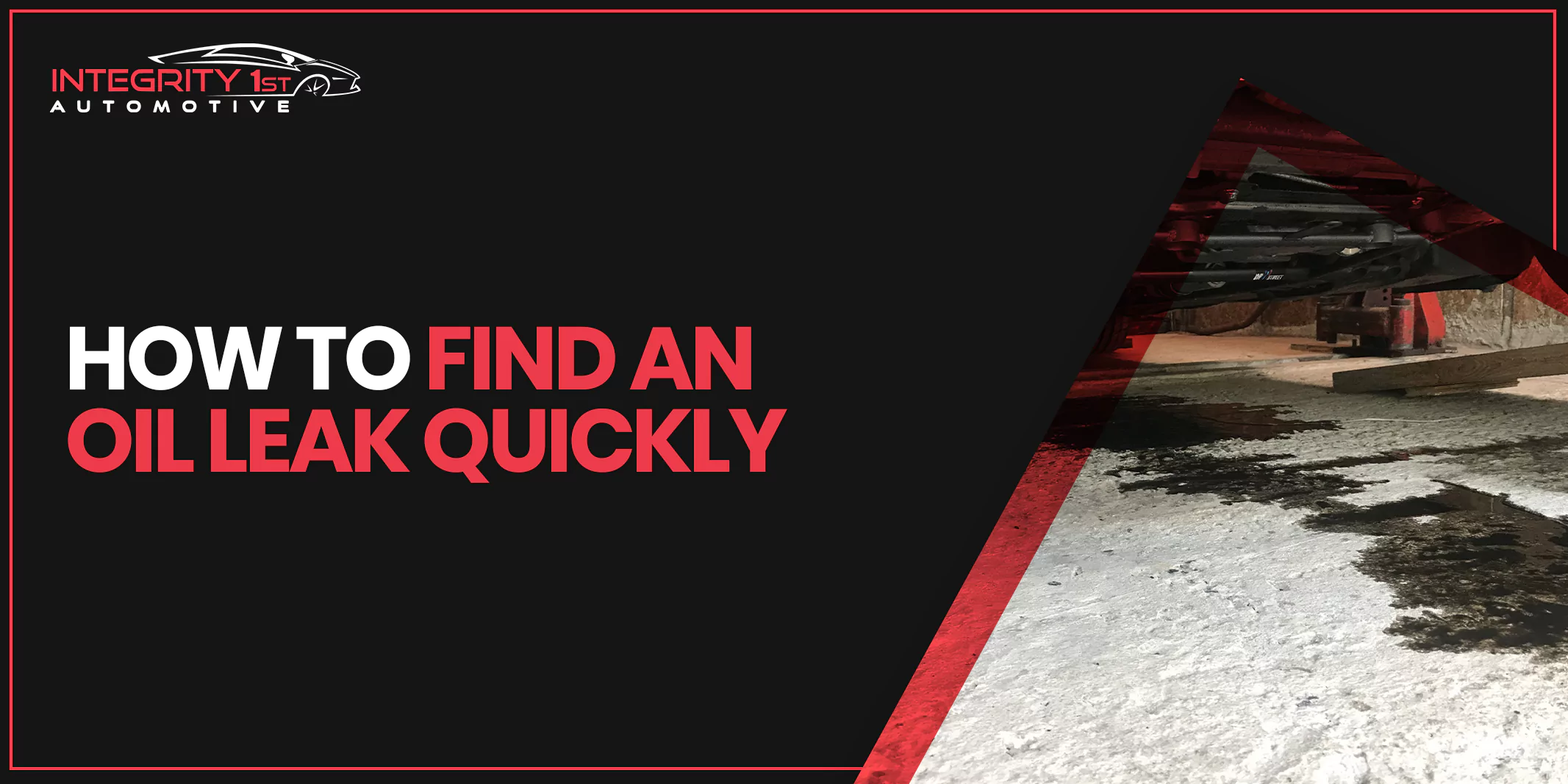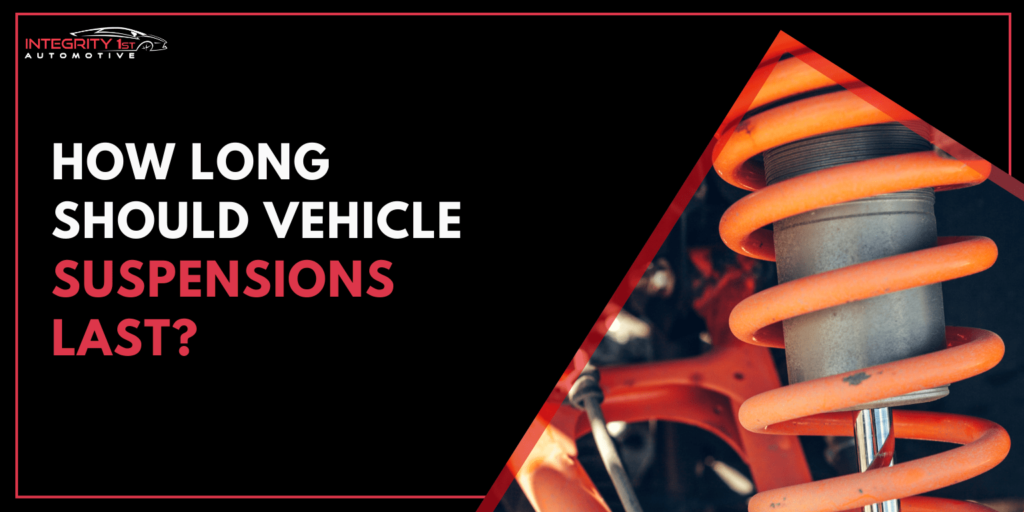Have you ever noticed a puddle of oil on your garage floor? Oil leaks are one of the biggest nightmares of car owners and are equally frustrating and dangerous. Most people wonder, “How to find an oil leak in a car?”
The good news is that you can find the origin of oil leaks with the right tools and techniques to get your vehicle back in shape.
In this article, we’ll explore the common causes of oil leaks and the effective locating methods. We will also provide some practical tips for temporary fixes.
Whether you’re dealing with a minor drip or a major issue, this article will teach you how to find an oil leak to maintain your vehicle’s health and performance.
Stay with us!
Step-by-Step Guide to Finding an Oil Leak
Don’t know where your oil is leaking from? No issues!
In this step-by-step guide, you’ll learn to narrow down the possibilities and address the issue effectively.

- Inspect the Oil Level
Insert a clean dipstick into the oil fill tube and check the oil level of your vehicle. Usually, your vehicle may leak oil in case of a low oil level.
Note: The oil level should be between the “Full” and “Add” marks. - Look for Visible Signs of an Oil Leak
Closely inspect the underside of your vehicle for visible marks or stains. You can also check the driveway or garage for signs of an oil leak. - Check the Oil Filter and Oil Pan
These are some of the most common areas for oil leaks. Therefore, inspect them thoroughly for any signs of leakage or damage. Additionally, check the oil pan gasket for any cracks or leaks. - Inspect the Valve Cover Gasket
Around the valve cover gasket, you’ll find signs of wear or damage in case of oil leaks. - Examine Seals and Gaskets Around the Engine:
Other seals and gaskets can also leak oil, including the crankshaft seal, camshaft seal, and transmission seal.
Check out these common areas for an oil leak and take suitable action to solve the issue.
Identifying Oil Leaks Using UV Dye and Light Method
Sometimes, identifying oil leaks can be a challenge. Thus, when all the other mentioned methods fail to locate the source of an oil leak, the UV dye and light method comes to the rescue.
In this technique, a fluorescent dye is added to the engine oil, easily detected by a black light. You can locate the source of an oil leak when the dye illuminates any area to identify the source.
Here’s how the simple process works:
- Add the UV dye to your engine’s oil
- Drive the vehicle for a short distance to allow the due to circulate through the oil system.
- On a clean, well-lit, and dry surface, park your vehicle and turn off the engine.
- When the vehicle is cooled, use a black light around the engine compartment and focus on areas where the oil leaks are suspected.
- Look closely for any areas that glow brightly under the black light to locate the source of an oil leak.
Note: Please follow these best practices for using leak detection tools.
- Always keep the engine compartment clean to avoid interference from other contaminants.
- Don’t settle for low-quality dyes. Invest in premium quality to ensure maximum results.
- Closely inspect all the areas of the engine compartment
- When things go out of hand, consult with a professional mechanic.
Common Causes of Oil Leaks
Oil leaks can be a result of simple wear or tear or major issues, including mechanical problems. Therefore, understanding the root cause of oil leaks is imperative to help identify the problem.

Oil Drain Plug and Filler Cap
Sometimes, a loose or damaged oil drain plug allows the oil to leak out. Furthermore, your improperly tightened filler cap may cause an oil leak in your vehicle.
Crankcase Ventilation
A faulty or clogged PCV valve can put unnecessary pressure on the crankcase, allowing oil to leak. Sometimes, a damaged breather hose may also cause crankcase pressure buildup, and ultimately, oil leaks.
Damaged Head Gasket and Crankshaft
A damaged head gasket can allow your coolant and oil to mix, which results in oil leaks. Furthermore, a damaged crankshaft seal allows oil to leak from the front or rear of the engine.
Valve Cover Gasket
A faulty or damaged valve cover gasket also allows oil to leak from the top of the engine. Most importantly, if the valve cover is installed improperly, it may leak oil.
Overfilling the Oil
Overfilling the tank with oil may force oil out of the seals, allowing it to leak. Therefore, it’s important to check oil levels and consult the owner’s manual to avoid inconvenience.
Engine Oil Cooler and Pressure Sensor
Leaky engine oil cooler lines can allow oil to leak and a faulty pressure sensor may give inaccurate readings, ultimately leading to overfilling the tank and potential leaks.
Note: Sometimes, aggressive driving can put extra strain on the engine, risking oil leaks. Also, always consider regular oil changes, filter replacements, and routine inspections to prevent oil leaks.
When to Seek Professional Help?
So, you’ve tried everything in your power to check for oil leaks in your vehicle, but to no avail? No issues. Here are some bonus warning signs you should look out for:
- If the oil pressure warning light appears, it indicates issues with the engine’s oil supply
- A noisy engine with performance issues indicates a drop in engine power, signaling oil leaks
- An unpleasant burning smell is a clear indication of an oil leak.
- If the oil levels in your vehicles are decreasing rapidly, it’s a serious sign of a leak.
Moreover, if you still fail to diagnose an oil leak or fail to locate the source of the oil leak, trust Integrity 1st Automotive to accurately detect your oil issues and propose a viable solution for it. Our expert team of professional technicians will help you with all automotive-related issues promptly.
Preventing Future Oil Leaks
Oil leaks are a common issue in most vehicles and while you cannot possibly eliminate the risk of oil leaks, there are some tips to prevent future oil leaks.
Firstly, your vehicle comes with an owner’s manual with the recommended oil change intervals. Follow the oil change intervals religiously to remove contaminants and maintain the overall lubricating properties of your oil.
Using the right type and viscosity of oil also helps prevent future oil leaks and premature wear and tear.
Also, during your routine auto maintenance calls, it’s important to ask your mechanic to inspect oil seals and gaskets for signs of wear and tear or damage. It’s recommended to replace the components that are showing signs of damage.
Finally, never ignore the oil leak; whether small or major. Always address the leaks promptly to prevent them from worsening and costly repairs.
Conclusion
So, now you know how to find where oil is leaking from and how to find an oil leak in a car. It’s time to be responsible and address the issues promptly. You can either locate the source of the oil leak by inspecting all the suspected components or through an oil leak test using UV dye and light methods.
Some of the main causes of oil leaks are overfilling the tank, damaged drain plug and filler gap, etc. However, you can prevent future leaks by following the oil change intervals, as suggested by your owner’s manual. Also, by using the right type of oil with viscosity.
All in all, finding oil leaks is not a difficult task, but to someone with limited knowledge, resources, and the right tools, it can become a nuisance to diagnose oil leaks. Therefore, we, at Integrity 1st Automotive offer comprehensive services that cater to your automotive needs.
Schedule a call with our experts today!
FAQs
What Oil Should I Use For My Car?
To know the recommended oil type and viscosity, refer to your owner’s manual.
Can You Check The Oil When The Car Is Hot?
It’s advised to check the oil when the engine is cold to get accurate readings.
What Happens If You Run Out Of Oil?
Running out of oil can cause serious engine damage.
Can I Mix New Oil With Old Oil?
Yes, it’s usually safe to mix new oil with old oil as long as the viscosities are not significantly different.
How High Should Oil Be On A Dipstick?
The recommended oil level should be on the “full” and “add” marks on the dipstick.



